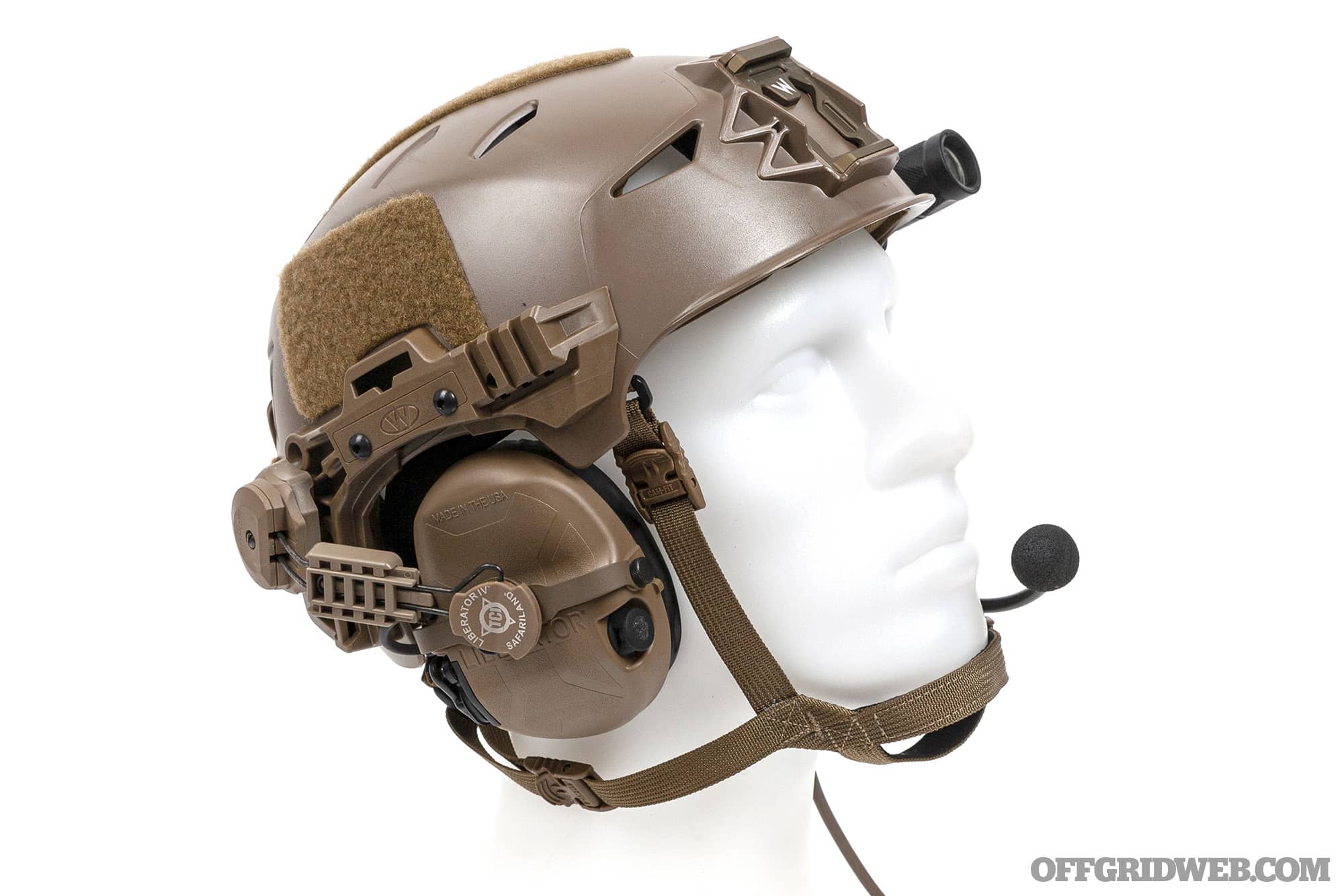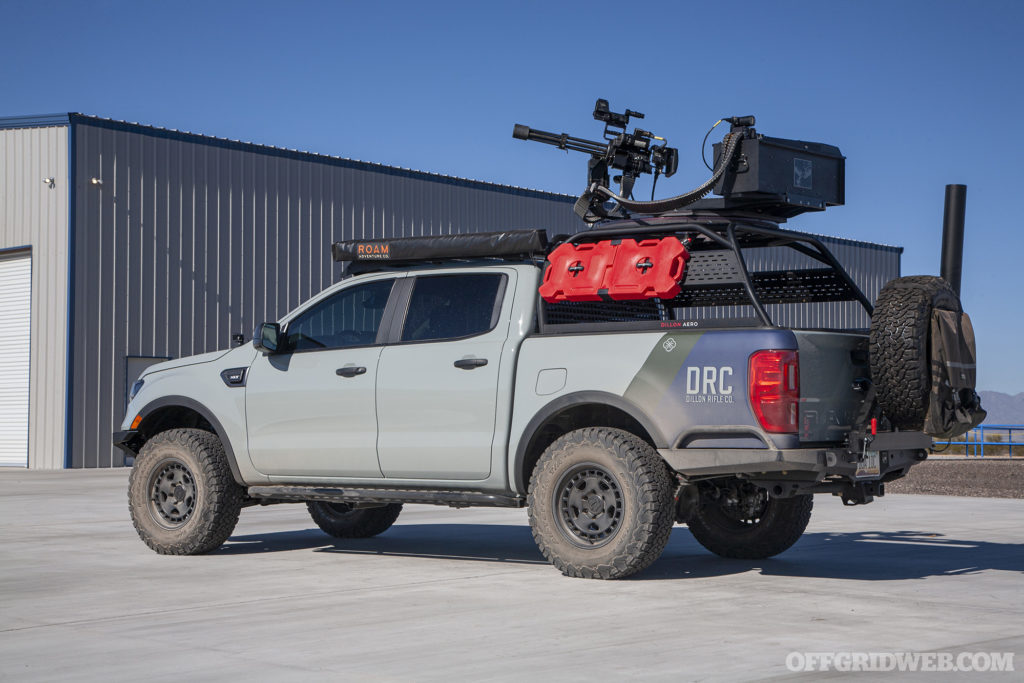Napoleon famously said, “The secret of war lies in the communications.” This concise statement reinforces the importance of communication at all levels of a fighting force — individuals, squads, platoons, companies, battalions, and so on. If communications are severed, the ability to coordinate often follows suit. Outside of a military context, the same principles apply to civilian emergency preparedness. If your group of family and friends is your squad, you should establish a solid plan for communications for any emergency. In yesterday’s article about encrypted radios, we provided an introduction to how encryption can help you ensure communication security (COMSEC). Today, we’ll take a look at two plate carrier radio setups from Safariland and Silynx that integrate our encrypted Off Grid Comms handhelds into our load-bearing gear.
Radio Setups & Applications
Above: Integrating a dual-comm setup into this TYR Tactical plate carrier was easy, with one radio placed on each side of the cummerbund.
You can do a lot better than clipping your radio to your belt or shoving it into a pocket. There’s a nearly endless ecosystem of accessories and upgrades for radios, especially popular models such as the Motorola XTS series. To make the most of your radio, we recommend integrating it into the rest of your gear. A few options to consider:
- Add a speaker mic so you can use the radio while it’s stowed in your hiking pack or on your duty belt
- Connect a low-profile earpiece so you can talk more discreetly in public
- Pair your radio with an active ear protection system for use at the shooting range, or other loud environments
- Build a complete dual-comm system that includes two radios on separate frequencies with a push-to-talk (PTT) button to activate each radio
Above: The Motorola XTS 3000 radios provided by Off Grid Comms can be used as stand-alone handsets, or can be connected to a variety of headsets and PTT systems.
Read on as we share two plate carrier radio setups configured by our staff. Each of these is connected to one of the Motorola XTS 3000 radios featured in our encrypted radio article. However, through the use of modular connectors, each of these systems can also be connected to a variety of other radios and comms devices.
Patrick McCarthy: Safariland Liberator V
I spend a lot of time shooting, whether it’s out in the desert with friends, at local competitions, or taking classes to learn about specific skills and weapon platforms. These activities don’t always require the same amount of gear — sometimes it’s just ear pro and eye pro, and other times it’s a full plate carrier, battle belt, and helmet with night vision system attached. With this in mind, I wanted a scalable, modular comms system.
The Safariland Liberator V is a professional-grade headset that integrates active ear pro and a dual-comm radio setup. Ordering the Liberator V reveals options for color (black, FDE, or OD green), left or right-side microphone placement, three types of suspension systems, two types of PTT controls, and even a gas mask input. Each system is made to order, and can be configured for a wide variety of military, law enforcement, and commercial radios. Certain configurations also offer a connector to integrate a cell phone into the system.
Above: Safariland’s Adaptive Suspension Kit allowed me to mount the Liberator V headset to the back of the rails on my Team Wendy helmet, keeping the top rails open for lights and other accessories.
Since the Liberator V is a dual-comm system, I requested connectors for two Motorola XTS radios. This allows me to use one in digital encrypted mode for secure communication with Off Grid Comms radios, and one in analog GMRS mode for general use, or use both in encrypted mode to communicate on two separate encrypted channels. Audio from both radios is piped into the headset, and I can control each from the two-button PTT. This configuration didn’t offer a cell phone connector, but I’m OK with that. My phone is clipped into a Juggernaut Case PALS mount for navigation and video-recording duties.
Above: This PALS Plate Carrier Mount from Juggernaut Case offers quick access to a cell phone for communication and navigation.
Both XTS radios are mounted on opposing sides of my TYR Tactical plate carrier’s cummerbund in Blue Force Gear elastic pouches. The PTT’s inline disconnects allow me to unplug or replace a radio without any hassle. In situations where I don’t need one of the radios, I can shove a rifle mag into the vacant pouch.
Safariland’s Adaptive Suspension system makes it possible to swap the headset from a headband to a helmet mount in seconds. When I’m training with night vision, I attach it to the Safariland rail mount installed on my Team Wendy Exfil LTP bump helmet. The rest of the time, I use the headset in the standard Comfort Fit headband. And in situations where I just need ear pro without comms — like casual range sessions with friends — I can disconnect the headset from the PTT and use it as active ear protection. Clear sound and comfy gel cups make the Liberator system easy to wear all day, no matter what I’m using it for.
Above: The Safariland Liberator V headset can be used as standalone ear protection, or it can be connected to the included push-to-talk button that offers control over two separate radios.
Tom Marshall: Silynx Clarus
Setting up my comms system, I was looking for two things. First, I wanted my communications system to be independent of my helmet. While over-the-ear muffs attached to helmet rails look cool and are awesome for combat operations where a helmet is mandatory, nowadays I rarely wear one outside of a photo shoot. Even working as a security contractor overseas, helmets weren’t widely used, even though comms capability was mandatory when rolling out of bed in the morning. The other factor important to me was a system that could integrate with multiple types of communication devices. While having an encrypted setup is a boon for family or neighborhood teams working together, prepared civilians cannot ensure everyone around them will be operating on the same frequency or even using the same radio platforms. Enter Silynx. Though their bread-and-butter is outfitting military and government organizations, almost all of their equipment is available to civilians, and they offer scaled hardware suites for a variety of applications.
I started with their Clarus dual-lead push-to-talk (PTT) box, the cornerstone of this entire setup. I wanted to make sure I had the ability to communicate within my family/team on the Off Grid Comms encrypted radios as well as outside elements or responders who may be talking to me on other devices. The Clarus has a modular split-cable adapter system allowing you to configure the PTT box to interface with multiple types of devices. Silynx offers adapters for a variety of device types. I focused on three: the Motorola XTS pattern, a two-pin adapter for Baofeng radios, and a 3.5mm headphone jack that’s compatible with smart phones.
After playing with a couple of different permutations, I settled on setting up my Arbor Arms Communicator Armor System (CAS) plate carrier to run the Silynx Clarus with one Motorola and my smartphone. The Motorola is stowed in an Esstac radio pouch on the left cummerbund arm of the CAS. The smartphone is on a Juggernaut Case phone case and PALS Adapter tray, which lets me attach my phone directly to my plate carrier for hands-free operation. It should be noted that most current-gen smartphones don’t have legacy-style headphone ports built in anymore. But there are small adapters available that will interface this jack with either USB-C or Apple Lightning Cable ports. Since I run a Galaxy phone, I purchased a $20 USB-C adapter from Amazon and was in business. This particular capability — integrating your cell phone into your radio communication setup — is perhaps the most unique and useful feature of the Silynx system for prepared citizens.
With this setup, I’m able to make a phone call and keep the line open hands free. But the person on the other end of the phone can only hear me when I press the corresponding transmit button on my Clarus PTT box. This is an outstanding capability to have if, for example, you have to call 911 and speak with first responders while also coordinating with a family member, neighbor, or friend who has an Off Grid Comms Motorola. Now you no longer have to be at the scene of the incident to direct responders to someone else who needs help — you can relay information remotely by having two lines of communication open. While a regular phone call will not be secure, you can use apps like Signal or Threema (both discussed in Issue 53), to make voice or video calls with end-to-end encryption, while still having the ability to transmit/receive through your Off Grid Comms Motorola, also encrypted.
Above: We used an Esstac pouch to secure the radio to the cummerbund, routing the wires through it and into the rear plate bag.
Since I specifically wanted my communications to be independent of a helmet, Silynx sent me their Clarus in-ear buds, which are equipped with an in-line microphone as well as their hear-thru and sound localization technology. This feature directionally amplifies low-level ambient sound to enhance situational awareness but cuts out when receiving or transmitting communication so you can have clear conversations over radio or phone. This technology functions much like current-generation active hearing protection systems, but with the added benefit of receiving radio and phone transmissions as well. It should be noted that the Clarus we used also has a modular top lead, meaning you can unhook the in-ear buds and switch to helmet-mounted muffs or boom mic-style headsets if that better fits your application.
Above: The Arbor Arms CAS 2.0 offers plenty of routing pass-throughs, which let us bury most of the Silynx wiring underneath the carrier.
I was able to route all my cables through sleeves integrated into the Arbor Arms CAS, to minimize the amount of cable exposed to snagging or environment damage. While the Silynx system does include clips that are sized to pass through MOLLE/PALS-style webbing, I used a couple of small zip-ties to fully secure the hardware to my carrier. Routing the antenna and PTT cables through one arm of the wraparound cummerbund lets me don and doff the carrier without having to swim through a sea of cables to get the carrier off.
My experience with Silynx’s communication hardware suite was excellent. Transmission and receiving quality were both clean and clear. The modularity of the Clarus system offers a high degree of flexibility for both user interface and communication/radio platform interface. There are also single-channel and fixed-lead versions of the Clarus available that’ll save you some money if you don’t need dual-comms capability or don’t plan on switching radio types.
Plate Carrier Radio Gear Sources
- Off Grid Comms > offgridcommsllc.com
- Safariland > safariland.com
- Silynx > silynxcom.com
- Juggernaut Case > juggernautcase.com
- Arbor Arms > arborarmsusa.com
- TYR Tactical > tyrtactical.com
Related Posts
The post Plate Carrier Radio Setups: Safariland Liberator & Silynx Clarus appeared first on RECOIL OFFGRID.






















